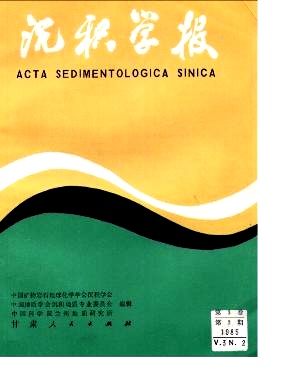Wang Zongzhe, Yangjiedong. CLAY MINERALS FROM THE STRATA NEAR THE CAMBRIAN- ORDOVICIAN BOUNDARY SECTION AT WUSHAN OF LULONG, HEBEI PROVINCE[J]. Acta Sedimentologica Sinica, 1985, 3(2): 57-66.
| Citation:
|
Wang Zongzhe, Yangjiedong. CLAY MINERALS FROM THE STRATA NEAR THE CAMBRIAN- ORDOVICIAN BOUNDARY SECTION AT WUSHAN OF LULONG, HEBEI PROVINCE[J]. Acta Sedimentologica Sinica, 1985, 3(2): 57-66.
|
CLAY MINERALS FROM THE STRATA NEAR THE CAMBRIAN- ORDOVICIAN BOUNDARY SECTION AT WUSHAN OF LULONG, HEBEI PROVINCE
- Received Date: 1983-08-29
- Publish Date:
1985-06-10
-
Abstract
Because of better exposure of rock outcrop, complete succession of the rock sequence, abundant critical fossils and typical marine sediments, Wushan section in Hebeei Province has been already considered an excellent Cambrian-Ordovician boundary stratotype site in northern China. The clay samples which were collected from the atrata near the boundary have been studied with the methods of X-ray diffraction analysis, electron microscope and infrared spectrometry. Figure 1 shows the simplified stratigraphic succession of the sedimentary sequence from the Cambrian-Ordovician boundary at Wushan section of Lulong Hebei, province,China. The 6,7,8,9,11,12 and13 levels are the units of the Upper Cambrians the 14 and 15 levels are those of the Lower Ordovician. According to the results of X-ray diffraction analyses from the clay minerals of the strata near the Cambrian-Ordovician boundary section at Wushan, illite is the major component of clay minerals in all levels. It is mixed up to 22% of chlorite in the 15 level of the Lower Ordovician, with up to 15% of vermiculite in the 6,7,8 and 9 levels of the Upper Cambrian, and with up to 25% chlorite-verrniculite randomly interstratified minerals in the 12 and 13 levels of the Upper Cambrian. By the investigation of electron microscope, the grains of illite are generally rather small and the shape of illite crystals is poor. The clay samples consist of platy aggrerates of tiny flakes of clay minerals. As a whole, the common texture is of a preferred orintation parallel to the bedding, many clay grains dip at angles to the bedding and show a "swirl" or "undulation" patterns. These stocks are loose packed. This texture develops a high porosity. The illite is dioctahedral, Fe-rich and of iMd type; the chlorite belongs to ripidolite which is trioctahedral and rich in Fej the vermiculite is trioctahedral with a high charge, which may be derived form the weathered mica-like clay minerals. The crystallinity indices of all the samples, which were measured accrding to the tno methods of weaver and dunoyer de segonzac, are all in the range of non-metamorphism. By the experimenrs, it is conjectured that during the transitional period between the end of Cambrian and the beginning of Ordovician, the sedimentary environment might not be quiet because of the turbulence in the seawater and might belong to neritic depost with rich cations, such as Fe and Mg. The seawater was shallower and nearer to the terrigenous region at the end of Cambrian than in the levels 14 and 15 at the beginning of Ordovician. The composition of clay minerals is partly different at the two sides of the boundary, which is probably caused by the differences of the ancient sedimentary environments. But this change is a gradual and continous transitionl one and there is no sharp change and disconnection near the boundary. It indicates that the the deposition is continous without breaks near the boundary at Wushan of Lulong.
-
References
|
[1]
|
(1)Thorez.J.,1976,practical identification of clay minerals, G.L elotte,Ed. Dison,Belgique.
(2)MaxwelI,D.T.and Hower, J.,1967,High-grade diagenesis and low-grade metam- orphism of illite in Precambrian Belt,Amer.Min.,52, 843-857。
(3)Weaver,C.E.,1960,Possibld uses of clay minerals in search for oil,Bull. Am.Assoc. Geol.44,I505-1518.
(4)Weaver,C.E.,1961,Clay minerals of the O nachita structural belt and adjacent foreland.in:the O nachita system,the U niv. T exeas Publ.,6120,Bureau Econ. Geol.Austin,147-160.
(5)Dunoyer de Segonzac,G.,1969,Les mineraux argileux dans la diagenese- passage au metamorphisme,Mem.29,serv Carte Geols. Als Lorr.,320p.
(6)Frey,M.,1970,The step from diagenesis to metamophism in pelitic rocks during Alpine Orogenesis,Sedimentology,15,261-279.
(7)Post, J.L.,and Plummer,C.C.,1972, T he chlorite series of Flagstaff Hillarea,California:a preliminary investigaton,Clays and Clay Min.,20,271-283.
(8)Johns,W.D.,Grim,R.E.and Bradley,W.F.,1954, Quantitative estimations of minerals by diffraction methods, J.Sed.Petrol,24, 242-251.
(9)Brindley,G.W. and De Kimpe, C.,1961,Identification of clay minerals by single crystal electron diffraction,T he A m erican mineralogist,46,P1005.
(10) Clauer,N.,1979, A ne w approach to Rb-Sr dating of sedimentary rock,In: E.Jager and J.C.Hunziker (Editors),L ectures in Isotope Geology,Springer- Verlag,Berlin, 30-51
(11) Kisck,H.J.,1983,Mineralogy and petrology of burial diagenesis(burial metam-orphism) and incipient metamorphism in elastic rocks,In:G.,Larsen and G.V., Chilingar (Editors),Developments in Sedimentology 25R, Elsevier, 289-494.
(12) White,W.A.,1961,Colloidal phenomena in sedimentation of argillaceous rocks, J .sediment.Petrol.,31,560-570.
(13) Meade,R.H.,1966,E actors influencing the early stages of the co m paction of claps and sands-review,).Sediment.petrol.,36,1085-1101. |
-
-
Proportional views

-






 DownLoad:
DownLoad: